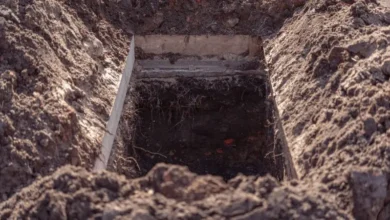Did ancient Egyptians use surgery to treat brain cancer?

Ancient Egyptians may have tried to treat cancer with surgery more than 4,000 years ago, a study has revealed.
The findings were published in May in the journal Frontiers in Medicine and add to a growing body of work seeking to expand our understanding of how one of the world’s most important civilisations tried to tackle diseases, especially one as deadly as cancer.
Why is this discovery significant?
Researchers have long known that medicine in ancient Egypt was more advanced than in many other ancient civilisations. Some of the earliest references to physicians date back to that period with procedures like bone setting and dental fillings common practice.
What scientists did not know until now was the extent to which its physicians may have tried to investigate and operate on cancerous tumours in the brain.
Scientists studying skulls from the era say they have found physical evidence of invasive procedures for brain tumours that prove physicians were trying to learn more about a disease we now call cancer. The discovery could also mark the first known case of surgical treatment for the disease in ancient Egypt.
“Our research observes, by looking directly into human bones with cancerous lesions, that they performed an oncological surgery,” lead author Edgard Camaros, a palaeopathologist studying ancient diseases at the University of Santiago de Compostela in Spain, told Al Jazeera. “We don’t know if this was a potential surgical treatment or a medical exploratory autopsy but for sure an oncological surgery to better understand what we nowadays call cancer.”
Alongside Camaros, researchers Tatiana Tondini of the University of Tubingen in Germany and Albert Isidro of the University Hospital Sagrat Cor in Spain co-authored the study.
How did scientists discover evidence of ancient surgery?
Two skulls, each thousands of years old, provided the evidence that both general healing treatments for head injuries and more specific cancer surgeries were undertaken in ancient Egypt.
Both were originally discovered in Egypt in the mid-1800s and are now part of the University of Cambridge’s Duckworth Laboratory skull collection in the United Kingdom, having been taken there by archaeologists for research.
One skull labelled 236 is believed to have belonged to a man 30 to 35 years old and dates back to 2687 BC to 2345 BC. Its scarred surface revealed one large lesion believed to be from malignant tumours as well as about 30 smaller lesions sprinkled across it. Researchers found cut marks all around the lesions, possibly made with a sharp metal instrument.
“We wanted to learn about the role of cancer in the past, how prevalent this disease was in antiquity and how ancient societies interacted with this pathology,” Tondini said in a statement. “When we first observed the cut marks under the microscope, we could not believe what was in front of us.”
The precise purpose of the incisions are not clear, and it is not known if the subject was dead or alive at the time. If the cuts were made posthumously, Camaros explained, then it could point to the fact that the physicians were conducting experiments or performing an autopsy.
If the patient was alive at the time, then the cutters were more likely trying to treat him. Without the patient’s medical history though, there is no way to be sure.
The second skull, labelled 270 and dating from 664 BC to 343 BC, is believed to be from a woman who was older than 50. It, too, has lesions believed to be from cancerous tumours although there are no signs of attempts to treat or observe it.
However, skull 270 has healed fractures from what was likely severe trauma from a weapon and continued to live long after those fractures were sustained. The fact that the individual survived could point to some form of successful medical treatment although it is unclear what that might be.
What else is known about cancer in ancient Egypt?
Ancient Egyptians believed diseases were a punishment from the gods, but they were nonetheless adept at medical care, using fresh meat, honey, lint and a host of herbs to treat wounds, for example. There were enough physicians in ancient Egypt that most were able to focus on one disease specialty, it is believed.
Cancer was likely not one of the diseases they understood enough to treat, as ancient texts have already shown – but not because the disease did not exist then. The rarity of cancer cases in fossil records led to a wide belief in the past that the disease, now the second leading cause of global deaths, is being caused largely by pollution and lifestyle or diet changes in the modern world.
But this latest finding, like others in recent history, has clarified that cancer was probably more common in the past than was once believed, the researchers said.
“Cancer is not a modern disease although lifestyle and ageing are important factors that increases its incidence,” Camaros said. “Cancer is as old as time and linked to multicellullar life, and therefore, humans suffered from oncological conditions since the very beginning. It is important to think that cancer was a much more prevalent disease than previously thought.”
In fact, early observed cases of cancer are believed to have been documented in an ancient Egyptian medical text now known as the Edwin Smith Papyrus. The 3,600-year-old document did not use the term “cancer” but there is little doubt among scientists that the “untreatable grave disease” it refers to is the same one scientists are still trying to understand and cure today.
Still, we know ancient Egyptians could diagnose cancer. They did this by looking at or feeling swellings and classifying them according to their characteristics – breast tumours with pus or tumours exhibiting redness, for example. Tumours were also classified by their feel, such as “hot” or “cold” tumours, historians said.
Ancient Egyptian physicians also pursued treatment, if not cures, for the disease, using cauterisation – burning off undesirable tumours – and bandaging them with therapeutic herbs for relief, according to the Edwin Smith Papyrus.










